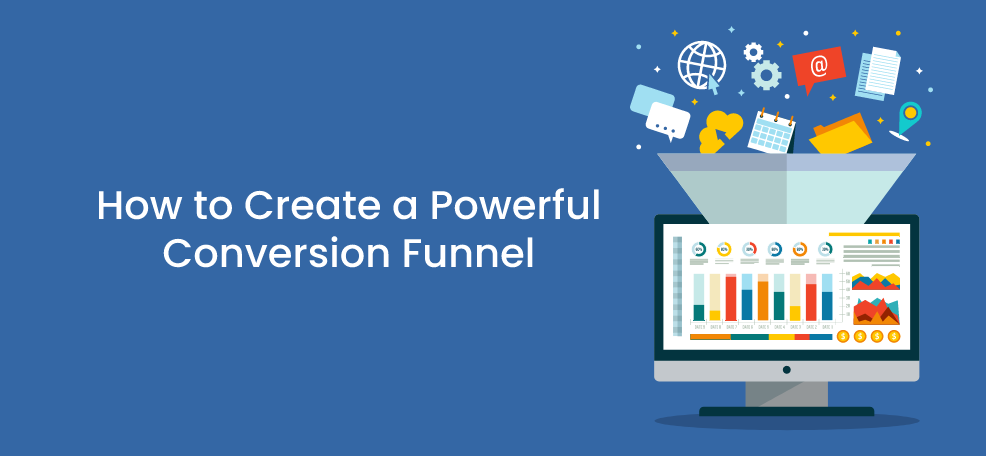Marketing funnels provide structure to your customer acquisition strategies. Designing and developing an efficient conversion funnel requires careful planning. You need to conduct competitive analysis, devise audience engagement strategies, select the most appropriate platforms for engagement, and more.
This guide will discuss how to create a powerful conversion funnel. I will walk you through some of the key things you should consider when creating a funnel. Just so we’re on the same page about everything, I’ll start this guide with a definition of a conversion funnel.
What is a Conversion Funnel
A Conversion Funnel is a map of the buyer’s journey from awareness to conversion and advocacy. The funnel is a metaphor for the incremental reduction in the number of potential leads as they progress along the conversion journey.
The funnel illustrates that the number of people who visit your website is greater than the number who engage with your brand and become customers.

Moreover, the funnel reflects that people who come across your business have different levels of understanding of your company. At the top of the funnel, you have people who have never come across your business before. At the bottom of the funnel, you have your superfans.
The activities at the top of your marketing funnel focus on building brand awareness within your target audience. Marketing activities highlight your products and services, demonstrate your professional competence, and build trust.
People at the top of your funnel aren’t ready to buy yet—they’re just getting to know you.
Marketing activities in the middle of the funnel focus on converting the general audience to leads and nurturing them towards conversion. Content strategies highlight the benefits of your products and services while differentiating your brand from the competition.
Case studies and reviews establish the credibility of your brand.
Marketing activities at the bottom of the funnel focus on converting the leads to customers. Strategies here focus on motivating your audience to act — your leads should believe that your product or service provides the best fit for their needs.
The bottom of your funnel will likely involve some offer.
The engagement of bottom-of-the-funnel activities doesn’t end with a conversion. It extends to converting the customer to a repeat buyer and a brand advocate.
Creating a conversion funnel is simply the process of creating an automated mechanism to turn leads into customers. Does it sound daunting? Well, it’s not.
When you break it down piece by piece, it’s not. Let’s take a look at each component of a conversion funnel separately and see how to put the pieces together.
1. Map Out Ideal Buyer’s Journey
The buyer’s journey depicts how a person researches a problem or an interest, conducts analysis, and then purchases a solution. Considering the consumer journey will help you identify the type of content you need to craft for each stage of the journey.

The following five stages make up the buyer’s journey:
- Awareness: A person in the awareness stage is seeking options to solve their problem or researching their interest, and the brand is creating awareness as a solution provider.
- Consideration: The individual grasps the problem and begins to consider possible solutions. Make your brand stand out from the rivals, so you attract new leads.
- Action: The person has a strategy in place and compiles a shortlist of vendors to make a purchase. The goal is to narrow down the number of choices on the list and make a purchase.
- Engagement: Keep your audience interested using social media even after they have made a purchase. Use customer service to build engagement and convert them to repeat customers.
- Advocacy: Build trust with your customers so that they want to recommend and promote your brand. Convert your customers to brand advocates.
Consider how your leads engage with your company and map out those stages. You can use tools like Google Analytics, your CRM, or other data sources to gain insights into how existing customers engage with your company. Identifying existing touchpoints will help you understand the customer journey and your content gaps.
Any point of contact between a company and a consumer or potential customer is a marketing touchpoint. It could be worth conducting interviews with customers to get additional insights.
2. Set Up Conversion Goals
An effective buyer journey requires you to set well-defined milestones and targets. You can set up conversion goals across the customer journey. If your website is the primary marketing channel for your business, I recommend monitoring conversions across your funnel.
There are various ways you can set up conversion goals. For example, you might track conversions from your blog to your email list for top-of-the-funnel content. Once they are on your email list, you might measure the CTR through to your site.
At the bottom of the funnel, you can measure sales. You can use goals and funnels to monitor micro-conversions, such as filling out a contact form or visiting particular pages that show interest.
You can use a variety of tools for monitoring conversions. For example, you could use Poptin for tracking conversions onto your email list. You could also use Google Analytics, for example, to track on-site conversions.
Setting up conversion goals on Google Analytics is straightforward. Log in to Google Analytics and go to the Admin settings tab. After you’ve chosen the View you want to work with, press “Goals.”
In the upper left corner, click “New Target.”
You have a few choices for setting up your goals from here. Templated options are available at the top of the list.

Popular goals include online registration, account building, inquiries, and social interaction. If any of these correlate to the conversions you want to track, the templates make it simple to set up specific objectives. Regardless of the goals you set, ensure you have a quantifiable method for measuring conversions.
3. Build Out Top of the Funnel Content
When you drew out the ideal customer journey, you probably identified gaps in your funnel. Those gaps are bits of information that your customers might find helpful but have yet to produce.
You’ll need to create suitable content to fill these gaps.
There are a variety of ways to identify relevant content you need to create. One of the most widely used methods is a content gap analysis. A content gap analysis is where you compare the content you have created against that of your competitors to identify content that you’re missing.
To convert visitors, you’ll need relevant and valuable content on your website. The content should help your visitors learn about your business, discuss their needs, and demonstrate what sets your company apart from your rivals.
Make sure you’re creating content for every stage of your funnel, from awareness to retention. Use a variety of forms of media, as well. For example, infographics are great for social media.
4. Develop Relationships with Email Campaigns
Once you have created content to generate leads, you need to develop that relationship with your audience. One of the best ways to do this is email marketing.
There are two types of email marketing campaigns you can run. There are drip campaigns where you send emails at predetermined times based on actions. Examples of drip campaigns include welcome emails, re-engagement campaigns, etc.
You should also send regular emails to your audience.
A drip campaign aims to attract the right subscribers and convert them through emails relevant to their interests.
When sending regular emails, you need to contact people regularly, so they remember your company, but not so often that subscribers feel that they’re getting spammed. It’s a tricky balance!
Part of the regular emails you send should generate sales.
When you combine the fitting reward with a magical discount, and you’ll get a conversion blast. Here’s how the Leesa team has incorporated a strong sales catalyst with a limited offer drip series.

A black Friday sale in July? That’s a brilliant idea!
Leesa sent an email at the beginning of the promotion and another as it neared its end. Subscribers who didn’t make a purchase received a special gift:

This email sequence is an example of a well-crafted campaign designed to push people down the conversion funnel. You should develop similar email marketing sequences and promotions.
5. Generate Conversions with Strong Offer
Getting people to move down your conversion funnel requires that they take action. To make them take action, you need to convince them the offer you’ve created fills their needs. That offer could be the incentive you provide to get people to join your email list, a bonus you provide with a purchase, the sale price for an item, or something else entirely.
Make sure that every conversion point along your funnel has a strong offer.
You also need to consider the sales copy that you use to generate that conversion. Your sales copy needs to hook the reader and make them understand the value of taking action.
Let’s look at Lifestraw, for example:

Their sales pages are designed to convert. Here are just a few of the things that they try to do to push a prospect into a customer:
- Provide a list of benefits before the buy button
- Shot the person what they will receive using appropriate visuals
- Use social proof in the form of ratings
- Add their USP – “one purchase = one year of safe water for one child.”
It’s important to ensure that you try to push your audience down your conversion funnel at each touchpoint. That involves optimizing your pages and the relevant CTA for conversions.
6. Test Your Funnel
To start analyzing your funnel’s effectiveness, you need to collect data and then analyze relevant data. You should check how people are engaging with your content and where those conversion points occur. For example, with Right Inbox, we have top-of-the-funnel content like “how to create a new Gmail address.”
Content like this generates a lot of traffic and a few leads. We then push our visitors down the funnel by sharing relevant content to email subscribers and other strategies.
We utilize tools like Google Analytics and others to monitor customer interactions at each touchpoint. You should implement the same approach for your business.
Through effective monitoring, you will identify opportunities to improve the conversion rates across your funnel. Incremental improvements will help generate more leads and customers for your business.
The Bottom Line
This guide discussed how to create a conversion funnel. Creating an effective conversion funnel begins by understanding the customer journey. You then build on that by filling out your content gaps, developing a relationship with your audience through various marketing channels, optimizing conversions, and monitoring the outcome.
Take the time to create a sales funnel that fulfills your target audience’s needs and business goals. Creating an effective conversion funnel won’t happen overnight. However, when things are running smoothly, you’ll be glad you made the necessary investment.
Author’s Bio

David Campbell is a digital marketing specialist at Ramp Ventures. He helps manage the content marketing team at Right Inbox. When he’s not working, he enjoys traveling and trying to learn Spanish.




